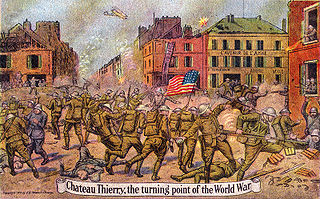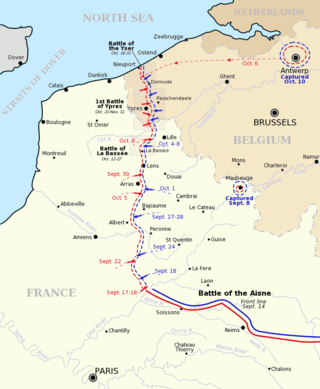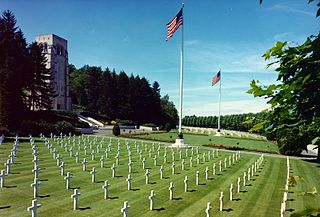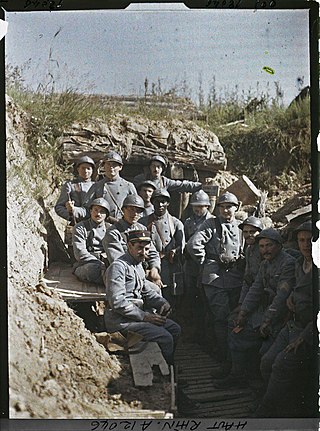Contents
| |||||
| Decades: | |||||
|---|---|---|---|---|---|
| See also: | Other events of 1918 History of France • Timeline • Years | ||||
Events from the year 1918 in France.
| |||||
| Decades: | |||||
|---|---|---|---|---|---|
| See also: | Other events of 1918 History of France • Timeline • Years | ||||
Events from the year 1918 in France.

The Second Battle of the Marne was the last major German offensive on the Western Front during the First World War. The attack failed when an Allied counterattack, supported by several hundred tanks, overwhelmed the Germans on their right flank, inflicting severe casualties. The German defeat marked the start of the relentless Allied advance which culminated in the Armistice with Germany about 100 days later.

The Battle of Belleau Wood occurred during the German spring offensive in World War I, near the Marne River in France. The battle was fought between the U.S. 2nd and 3rd Divisions along with French and British forces against an assortment of German units including elements from the 237th, 10th, 197th, 87th, and 28th Divisions. The battle has become a key component in the lore of the United States Marine Corps.

The Battle of Amiens, also known as the Third Battle of Picardy, was the opening phase of the Allied offensive which began on 8 August 1918, later known as the Hundred Days Offensive, that ultimately led to the end of the First World War. Allied forces advanced over 11 kilometres (7 mi) on the first day, one of the greatest advances of the war, with Gen Henry Rawlinson's British Fourth Army playing the decisive role. The battle is also notable for its effects on both sides' morale and the large number of surrendering German forces. This led Erich Ludendorff to later describe the first day of the battle as "the black day of the German Army". Amiens was one of the first major battles involving armoured warfare.

The Battle of Château-Thierry was fought on July 18, 1918 and was one of the first actions of the American Expeditionary Forces (AEF) under General John J. Pershing. It was a battle in World War I as part of the Second Battle of the Marne, initially prompted by a German Spring Offensive. German and local actions at Château-Thierry recommenced on May 31 to July 22, 1918, against the AEF, an American Expeditionary Force, consisting of troops from both the United States Army and Marine Corps units. These units were the newest troops on the front in France and just barely out of training.

The Hundred Days Offensive was a series of massive Allied offensives that ended the First World War. Beginning with the Battle of Amiens on the Western Front, the Allies pushed the Imperial German Army back, undoing its gains from the German spring offensive.

The First Battle of the Aisne was the Allied follow-up offensive against the right wing of the German First Army and the Second Army as they retreated after the First Battle of the Marne earlier in September 1914. The Advance to the Aisne consisted of the Battle of the Marne (7–10 September) and the Battle of the Aisne (12–15 September).

The Third Battle of the Aisne was a battle of the German spring offensive during World War I that focused on capturing the Chemin des Dames Ridge before the American Expeditionary Forces arrived completely in France. It was one of a series of offensives, known as the Kaiserschlacht, launched by the Germans in the spring and summer of 1918.

The United States campaigns in World War I began after American entry in the war in early April 1917. The American Expeditionary Force (AEF) served on the Western Front, under General John J. Pershing, and engaged in 13 official military campaigns between 1917 and 1918, for which campaign streamers were designated. The streamer uses the colors of the World War I Victory Medal ribbon which had a red center with a rainbow on each side of the center stripe and a purple edge. The double rainbow symbolizes the dawn of a new era and the calm which follows the storm.

The Aisne-Marne American Cemetery and Memorial is a 42-acre (17 ha) World War I cemetery in Belleau, Northern France. It is located at the foot of the hill where the Battle of Belleau Wood was fought, with many American fatalities. The cemetery also contains burials from the Battle of Château-Thierry, later that summer.
The 28th Reserve Division was a unit of the Imperial German Army in World War I. The division was formed on the mobilization of the German Army in August 1914 as part of the XIV Reserve Corps. The division was disbanded in 1919 during the demobilization of the German Army after World War I. The division was raised primarily in the Grand Duchy of Baden.
Events from the year 1914 in France.
Events from the year 1941 in France.
This is a list of events from 1917 in France.

During World War I, France was one of the Triple Entente powers allied against the Central Powers. Although fighting occurred worldwide, the bulk of the conflict in Europe occurred in Belgium, Luxembourg, France and Alsace-Lorraine along what came to be known as the Western Front, which consisted mainly of trench warfare. Specific operational, tactical, and strategic decisions by the high command on both sides of the conflict led to shifts in organizational capacity, as the French Army tried to respond to day-to-day fighting and long-term strategic and operational agendas. In particular, many problems caused the French high command to re-evaluate standard procedures, revise its command structures, re-equip the army, and to develop different tactical approaches.

The Château-Thierry American Monument is a World War I memorial, dedicated in 1937, located near Château-Thierry, Aisne, France. Architecturally it is a notable example of Stripped Classicism.
The War Memorials of Aisne or Monuments aux Morts of Aisne are French war memorials in the Aisne, in the region of Picardy, commemorating those men of the Aisne region who died in World War I
Alfred-Alphonse Bottiau was a French sculptor. He was born in Valenciennes and after early studies in his home town he studied in Paris under Jean Antoine Injalbert and was runner-up for the Prix de Rome for sculpture in 1919. Bottiau had joined the army in 1910 and served until 1919. He was director of the Écoles Académiques de Valenciennes from 1946 to 1951.

The following events occurred in June 1918:

This is the American Expeditionary Forces on the Western Front order of battle. The American Expeditionary Forces (AEF) consisted of the United States Armed Forces that were sent to Europe in World War I to support the Allied cause against the Central Powers. During the United States campaigns in World War I the AEF fought in France alongside French and British allied forces in the last year of the war, against Imperial German forces. Some of the troops fought alongside Italian forces in that same year, against Austro-Hungarian forces. Late in the war American units also fought in Siberia and North Russia.